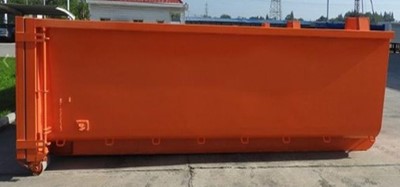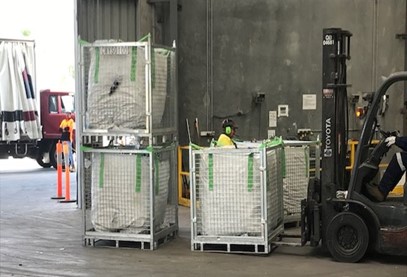Once the Refund Point Operators (RPOs) have received containers from the public, the containers still have multiple steps along the way before they can be recycled:
- Containers must be collected by the scheme’s appointed logistics providers. The scheme network has approximately 110 aggregation points which are serviced by our logistics providers within excess of 20 trucks servicing this network at any given time.
- The material from these aggregation points is taken to one of our nine processing facilities across the State in collection infrastructure provided by processors.
- These processors will prepare the containers for commercial sale, which might include baling of plastic, aluminium, and other non-glass containers, and crushing and beneficiation of glass.
- Once the materials are prepared for commercial sale, they are sold to members of the approved recycling panel, who are either processors of recycled products or sellers to such processors.
Collection infrastructure
Each aggregation point will be allocated collection infrastructure such as 1100L bins, hooklift bins, skip bins, cages, and bulka bags to store containers on site for logistics providers to pick up.

Hook Lift Bin used for glass by West Tip in Metro

Single Cages used by Cleanaway in regional areas
Contingency storage and internal handling equipment
Operators should have contingency storage, such as bulka bags, to ensure they can maintain operations when receiving unexpectedly large daily volumes or due to delays by the logistics provider.
Aggregation and Refund Points are required to have their own internal handling equipment to get containers from sorting tables and counting machines into collection infrastructure, which includes smaller receptacles, bins, and bags.
To assist in moving redeemed containers around within Refund Points and aggregation points, we strongly recommend you have a forklift (preferably with rotating arm) as part of your materials handling equipment. This will make moving containers around and into the collection infrastructure both easier and safer, particularly when handling glass.
Material collection
It is important that aggregation point operators prepare collection infrastructure for pick up by logistics providers.
This includes:
- Setting up the collection infrastructure with the unique identifier in POS matching what is marked on the equipment.
- Moving the collection infrastructure to a designated pick-up area.
- Sending the manifest to the logistics operator prior to arrival, or having it ready to go when the truck is on site.
By having bins and cages full and manifests ready before the logistics provider arrives for collection, operators will minimise the time they need to spend at their aggregation point and any disruption that might be caused to their operations.
Lids collection
Collection infrastructure will also be provided for lids in the form of wheelie bins and/or bulka bags, which will be picked up by logistics providers.
In city areas there is a set lid pick up schedule, however in regional areas lids can be collected by most trucks — they just need to be recorded on the manifest and the driver must be informed.
It is important that RPOs do not accept containers with lids from customers and monitor lid collection infrastructure for contamination.
Collection infrastructure safety
Compaction equipment: While working with compaction equipment such as compactor trucks, on-site compaction units and balers, it is imperative that no person ever enters or reaches inside this equipment. Compaction equipment is designed to compact material at great force and needs to be treated with absolute care and safety while in operation. If there is any type of mechanical issue, including a bin or other receptacle falling into or becoming lodged in the equipment, the owner of the equipment needs to be contacted and a qualified person needs to undertake any repairs or retrieval of bins. This includes any bins or receptacles falling into glass hook bins or skips. Refund points should never tamper with or try and open a glass hook or skip bin door. You can find safety signage for your compactor here (COMPACTOR SIGNAGE PET and ALU).
Glass collection infrastructure: RPOs need to ensure glass bins are not over filled (max fill line is marked, 10cm under the bar) and that there is a relatively even distribution of glass within the bin. All scheme bins will have a fill line sticker on them on the outside of the bin. This is the same for glass cages, they must only be filled to 10cm below the top. If a bin is overfilled by an operator, please contact your logistics provider or WARRRL to work through a safe collection plan.
Contamination
It is imperative that only eligible containers be put into collection infrastructure and that each type of material is kept separate.
Any form of contamination — whether it be other container types, dirt, gravel, food or garden waste and construction material — can cause major issues for our processors. It can ultimately lead to the material not being able to be recycled and causing major damage to the plant and equipment of our processors.
Sand and gravel found in glass bins has already caused issues at our glass processing facility and must not in any circumstances be loaded into a glass bin, even in small quantities.
If contamination occurs, it is imperative the operators advise logistics operators and WARRRL as soon as possible.